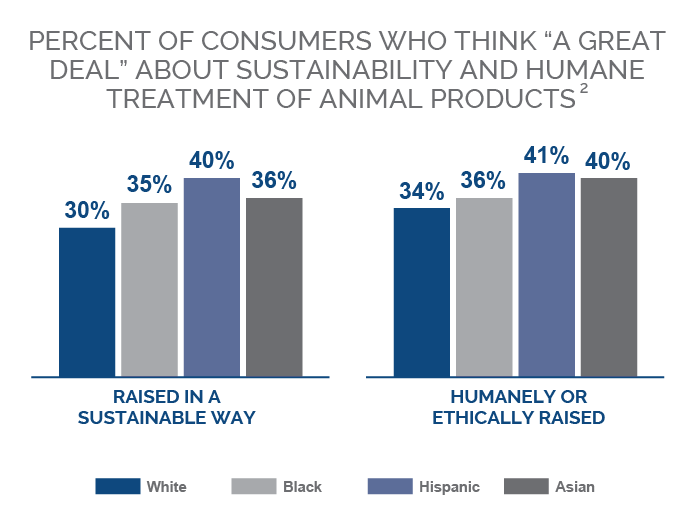Where are they purchasing fresh meat?
Meat consumers of all ethnicities are shopping at retailers like traditional full-service supermarkets, supercenters and warehouse club stores. While 64% of White shoppers opt for traditional supermarkets, these are not the retailers most visited by Black, Asian and Hispanic consumers. Black shoppers are most likely to shop at a supercenter, with 55% indicating they’ve visited a supercenter in the last month. They are also more likely than other ethnicities to have visited a deep discount grocery store like ALDI. Asian shoppers also have a diverse range of retailers they visit. Half of Asian meat consumers visited a warehouse club store in February, while 37% visited a health, natural or organic food store and 27% visited an ethnic grocery store (which is significantly more than other groups). Most notably, Hispanics are statistically more likely than other shoppers to have purchased meat online.2
More than 60% of Hispanic meat consumers purchased meat online in February. Their primary online method was purchasing from a local grocery store for pickup or delivery. Black (55%) and Asian (52%) meat consumers are also more likely to have purchased meat online than White (42%) consumers. Black shoppers are the most likely to have used a meat-specific delivery service like Crowd Cow while Asian and Hispanic shoppers are the most likely to have purchased meat using an online delivery service like Instacart.2
If your store has a growing multicultural consumer base, consider what changes you may need to make to your online platforms. Are all your products available in-app, including those from the ethnic aisles? Can shoppers buy products from the full-service meat counter online as well as in-store? Also look at what you can do in your physical store to meet your shoppers’ expectations. If your customer base skews Asian, consider offering more natural and organic beef options; for Hispanic-dominated communities, perhaps offer more items in bulk sizes.

What are they buying?
Regardless of ethnicity, poultry is the protein most likely to be consumed at most meals. While about half of consumers across races say poultry is the main dish at most of their meals, the percent of Black consumers is even higher at 58%. Beef is the secondary protein for all ethnic groups, but Hispanic and White consumers are more likely than other groups to consider it their primary protein. Asian consumers seem to have the most diverse protein selections, with more than 60% of shoppers saying they have pork, seafood and vegetarian options as a main dish at least once per week. Black consumers also over-index on seafood as a main dish, with 55% having it as a main dish regularly.2
When it comes to plant-based meat alternatives, the multicultural consumers vary greatly. More than 60% of Asian meat consumers have eaten plant-based meat alternatives either from a store or restaurant. This is closer to 50% for Black, White and Hispanic shoppers. Asian consumers are also more likely to say they eat plant-based regularly, with a quarter saying they eat these alternatives at least once per month.2
What else are they considering?
The attitudes and priorities of ethnic groups are likely the areas they differ most. Beginning with claims on their beef and pork, Hispanic shoppers look for pork claims at a higher rate than other consumers, while Asian shoppers over-index on several beef claims. More than 25% of Hispanic consumers look for no added hormones claims for their beef and pork and nearly the same number look specifically for GMO-free beef. Hispanic shoppers are also the most likely to purchase imported beef and pork at least once per month.2
Asian meat consumers look for USDA Organic and all-natural beef at a higher rate than other groups. Similar to Hispanics, about 25% of Asian shoppers are also buying beef and pork raised without added hormones each month. Black consumers, on the other hand, purchase claims-based beef less than other consumer groups but do still purchase pork with claims.2
When purchasing fresh meat, Black, Hispanic and Asian consumers are significantly more likely to consider whether the animals were raised sustainably compared to their White counterparts. Hispanic and Asian shoppers are also more likely than others to consider whether the animals were humanely or ethically raised.2

Curating a store that reflects your shoppers is integral to being your community’s grocer of choice. Only around 12% of shoppers, regardless of ethnicity, purchase meat somewhere other than their primary grocery outlet, making it even more important that your meat case has the variety of products your customers are shopping for.2 In 2030, nearly half of Americans will identify with an ethnicity other than White1 – what do you need to start working on today to best serve the customers of tomorrow?
1 U.S. Census Bureau, Demographic Turning Points for the United States: Population Projections for 2020 to 2060. February 2020.
2 Midan Marketing, The Multicultural Meat Consumer. March 1-5, 2021.
This content originally appeared in The Shelby Report.
Methodology
Midan Marketing fielded an online survey with samples of Black, White, Hispanic and Asian consumers. The survey was taken by consumers 18 to 74 years old who are primarily responsible or who share responsibility for grocery shopping and food preparation. They also must have eaten beef or pork during the past month.
